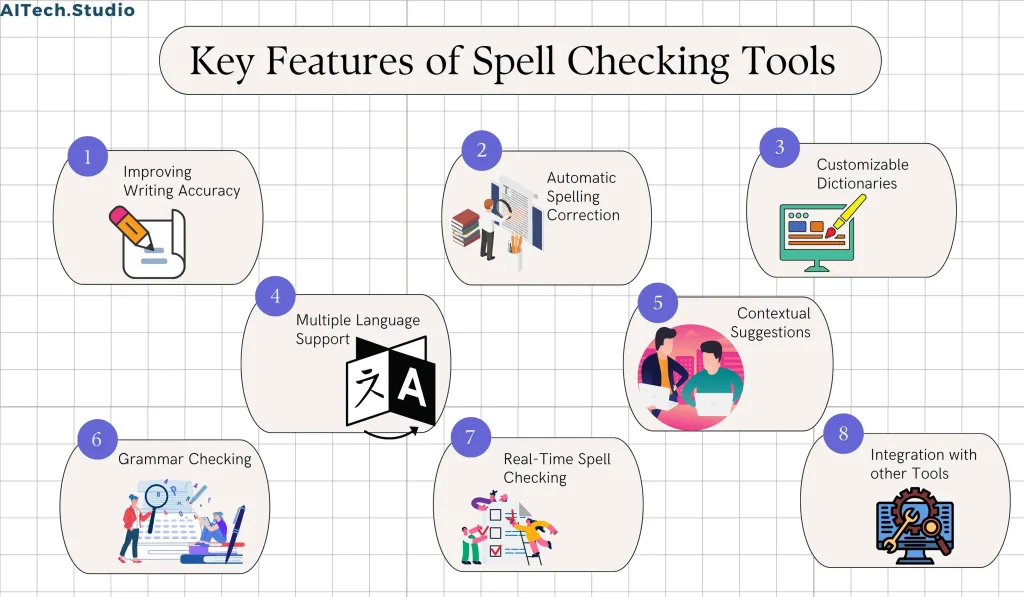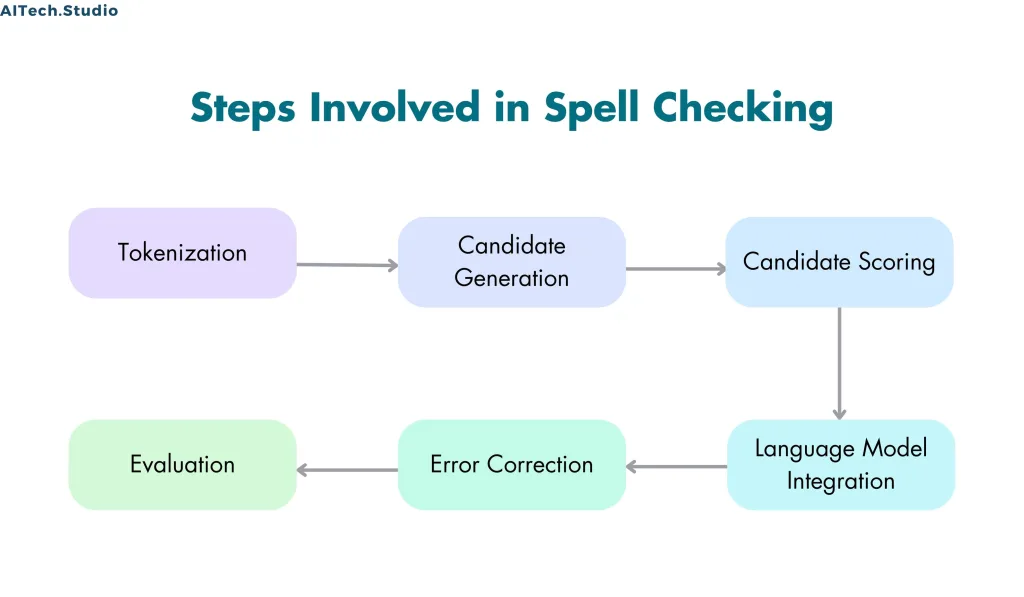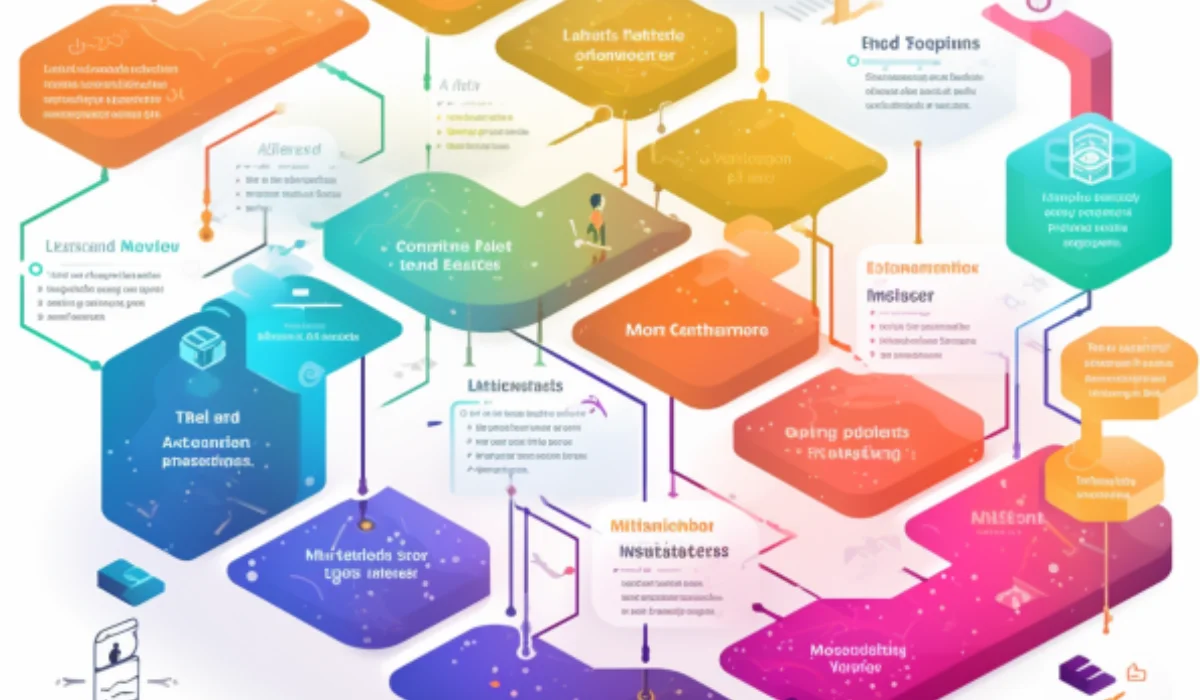As technology advances spell checking, in Natural Language Processing (NLP) has become crucial for writers and editors alike. Its main purpose is to ensure the accuracy of text by catching spelling errors, typos, and grammar mistakes. With the progress in natural language processing spell checking has developed to handle tasks such as grammar checking and rephrasing. This guide aims to give an overview of spell check and delve into improvements, in NLP.
Furthermore, we will explore five words that are known to improve the flow of writing. We will also assess how these words impact reader understanding through examples demonstrating their use. Lastly, we will summarize the insights gained from our exploration.

What is Spell-Checking?
Spell-checking is an aspect of Natural Language Processing (NLP). It involves an automated process that detects and corrects spelling errors in text. However it goes beyond fixing typos; it also addresses grammar issues, punctuation mistakes, and other writing errors.
In today’s society, where written communication is increasingly important the importance of spell-check cannot be emphasized enough. With the rise of platforms, like email and social media ensuring error content has become essential. Not only does it showcase professionalism and credibility. It also improves the clarity and accuracy of the message being conveyed.
Furthermore, the benefits of spell-checking are felt across fields. In academia, flawless writing is crucial for research publications as mistakes can cast doubts on the validity of findings. In business, polished communication can. Break deals with clients. Similarly in medical settings, precisely written documents can have implications, on legal decisions or patient well-being.
By using NLP methods, for spell checking, we can quickly. Fix errors, as well as study common mistake patterns to enhance language skills. Spell does not maintain the correctness and quality of written material. Also aids in honing linguistic abilities. Essentially efficient spell-checking is an asset in communication promoting clearer more accurate and impactful exchanges, in various fields.
Techniques
- Dictionary-Based Spell Checking
- Dictionary-based spell-check involves comparing words in the text to words in a dictionary. Moreover, the system flags a word as a spelling error if it is not found in the dictionary.
- Dictionary-based spell-checking is the most straightforward technique but has limitations. It cannot handle homophones or out-of-vocabulary words.
- Rule-Based Spell Checking
- Rule-based spell-checking involves applying a set of rules to the text to detect and correct errors. Moreover, rules can include detecting repeated words, capitalization errors, and other common mistakes.
- Rule-based spell checking is more advanced than dictionary-based spell check but requires more effort to set up.
- Statistical Spell Checking
- Statistical spell-checking, on the other hand, involves using statistical models to detect and correct errors. These models, moreover, analyze the frequency of word occurrences in a given corpus of text to identify common mistakes.
- Statistical spell-checking is more accurate than dictionary-based and rule-based spell-checking but requires a significant amount of data.
- Hybrid Spell Checking
- Hybrid spell-checking combines two or more of the above techniques to improve accuracy and coverage.
- For example, a hybrid spell checker could use a dictionary-based to detect simple errors and a rule-based to handle more complex errors.
Features
In this article, we will explore the key features of spell-check and how they can improve writing accuracy.

- Improving Writing Accuracy
- If you are a writer, student, or anyone who uses a computer for written communication, you know how important it is to have accurate spelling.
- Users can identify and correct spelling errors with the help of developed spell-checking tools.
- Automatic Spelling Correction
- When enabled, this feature highlights misspelled words and suggests correct spellings.
- In many cases, the correction happens automatically, without any action required from the user.
- Customizable Dictionaries
- Spell-checking tools often allow users to create and edit custom dictionaries.
- Adding specific industry-related terms or names that are not recognized by the default dictionary is useful.
- Multiple Language Support
- With the rise of globalization, the ability to spell check in multiple languages has become increasingly important.
- Spell-checking tools can support multiple languages, allowing users to switch between languages seamlessly.
- Contextual Suggestions
- Another key feature of spell-checking is contextual suggestions.
- Contextual suggestions do not only offer a list of possible correct spellings, but they also take into account the context of the word being checked.
- Grammar Checking
- Some spell-checking tools also offer grammar-checking features.
- These tools can identify and correct common grammar errors, such as subject-verb agreement and sentence fragments.
- Real-Time Spell Checking
- Real-time spell checking is a feature that checks for spelling errors as the user types.
- This means that misspelled words are highlighted and corrected immediately, without the need for a separate spell-checking process.
- Integration with other Tools
- Finally, spell-checking tools can be integrated with other tools, such as word processors and email clients.
- This allows users to access spell-checking in NLP features directly within the application they are using, without the need for separate software.
Importance
- Spell checking in NLP is an essential tool for anyone who creates or edits written content.
- It can help to catch spelling mistakes, typos, and other errors that can undermine the quality of the text.
- Spell-checking in NLP can also save time and effort by reducing the need for manual proofreading.
- This is particularly important in situations where large volumes of text need to be checked.
Steps Involved in Spell Checking

- Step:1 Tokenization
- The first step in spell-checking is to break the text into individual words or tokens.
- This process is called tokenization and is necessary to identify spelling errors at the word level.
- Tokenization can be performed using various techniques, such as whitespace tokenization, rule-based tokenization, and statistical tokenization.
- Step:2 Candidate Generation
- Once the text has been tokenized, the next step is to generate a list of candidate corrections for each misspelled word.
- This process is called candidate generation and involves searching a dictionary or corpus for words that are similar to the misspelled word.
- There are two main approaches to candidate generation: dictionary-based and statistical-based.
- Step:3 Candidate Scoring
- After generating a list of candidate corrections, the next step is to score each candidate based on its likelihood of being the correct spelling.
- We apply various linguistic and statistical models to evaluate the candidates in a process called candidate scoring.
- Step:4 Language Model Integration
- To enhance the accuracy of spell-checking, numerous algorithms incorporate language models that effectively capture the statistical patterns inherent in natural language. Moreover, these language models serve as valuable tools in refining the precision of spell-checking systems.
- These models can be trained on large corpora of text and can provide context-specific information to aid in candidate scoring.
- Step:5 Error Correction
- Once the candidates have been scored, the final step is to select the most likely correction and apply it to the text.
- This process is called error correction and involves replacing the misspelled word with the selected correction.
- Some error correction techniques include maximum likelihood estimation, Bayesian inference, and rule-based methods.
- Maximum likelihood estimation selects the candidate with the highest probability
- Step:6 Evaluation
- To ensure the accuracy and effectiveness of spell-checking algorithms, we can use various evaluation metrics.
- Some common metrics include precision, recall, and F1-score.
The Best Spell-Checking Tools
- Antidote
- The Antidote is a powerful writing assistance software designed to help users improve their writing skills in English and French.
- The software offers a range of features, including grammar and spelling checks, style suggestions, and contextual vocabulary analysis.
- Linguix
- Linguix is an AI-powered writing assistant designed to help writers improve their writing skills and produce high-quality content.
- The platform offers a range of features, including grammar and spelling checks, style suggestions, and vocabulary enhancement tools.
- Writer.com
- Writer.com is an AI-powered writing assistant tool designed to help writers improve their writing skills and produce high-quality content. Additionally, this innovative platform offers a range of transition words to enhance the flow and coherence of their writing.
- The platform offers a range of features, including grammar and style checks, plagiarism detection, and readability analysis. It also provides personalized writing goals and recommendations, allowing writers to refine their writing style and achieve their desired outcomes.
- AutoCrit
- AutoCrit is an online editing tool designed to help writers improve the quality of their writing. The software analyzes a manuscript’s content and provides detailed feedback on areas such as pacing, dialogue, and sentence structure.
- The software is available as a subscription service, with different plans and pricing options available depending on the user’s needs.
- Microsoft Word
- Microsoft Word is a popular word-processing software developed by Microsoft. Moreover, it allows users to create, edit, and format various types of documents, including letters, reports, and resumes.
- The software offers a range of features such as spell-checking, grammar-checking, and thesaurus, making it a valuable tool for both personal and professional use.
Challenges
Despite the advances in spell-checking technology, we still need to overcome several challenges. These include:
- Homophones
- Homophones are words that sound the same but have different meanings and spellings. Spell checkers need to be able to detect homophones and suggest the correct spelling based on the context of the text.
- Contextual Spelling Errors
- Contextual spelling errors occur when someone uses a word correctly in terms of spelling but incorrectly in terms of context. Spell checkers need to be able to analyze the context of the text to detect and correct these errors.
- Out-of-Vocabulary Words
- Furthermore, we call words that do not appear in a dictionary or corpus of text out-of-vocabulary words. Additionally, spell checkers need to be able to handle these words to avoid flagging them as spelling errors.
- Domain-Specific Language
- A Domain-Specific language is a language that is specific to a particular field or industry. To ensure that they do not flag these types of language as errors, spell checkers need to handle them.
- Non-Standard Language
- Moreover, people do not typically use non-standard language in formal writing. Consequently, spell checkers need to be able to handle non-standard language to avoid flagging it as an error.
- Multilingualism
- Multilingualism is the ability to speak or write in multiple languages. Moreover, in a globalized world, spell checkers need to be able to handle multiple languages to be truly useful.
Conclusion
In conclusion, spell-checking is an essential tool for anyone who creates or edits written content. It helps to catch spelling mistakes, typos, and other errors that can undermine the quality of the text.
Natural language processing has played a significant role in the development of spell-checking technology, making it more sophisticated and accurate. Moreover, there are four main techniques for spell checking, including dictionary-based, rule-based, statistical, and hybrid spell check.
Spell-checking technology has made significant advances, but it still needs to overcome several challenges, such as homophones, contextual spelling errors, out-of-vocabulary words, domain-specific language, non-standard language, and multilingualism.









